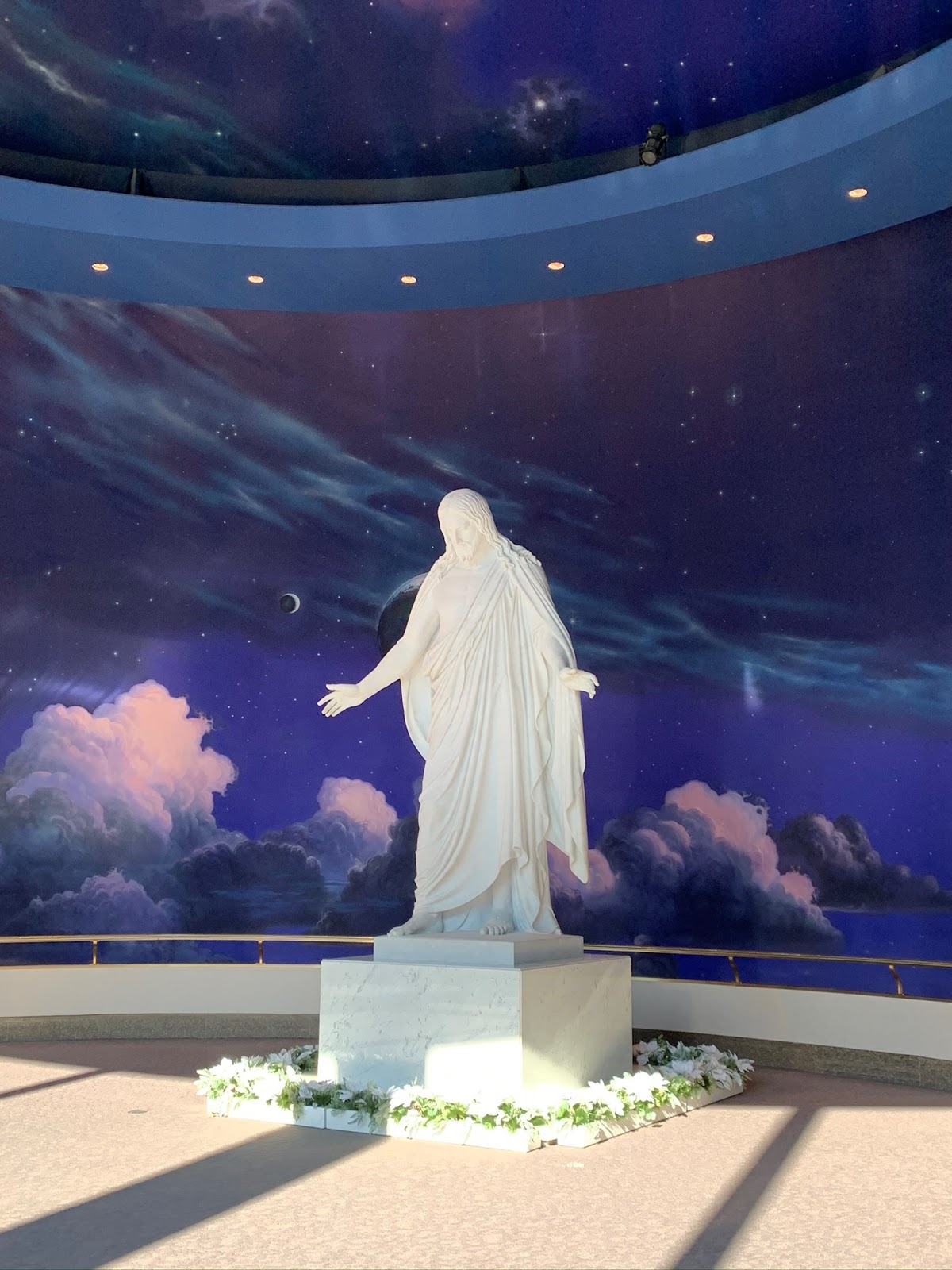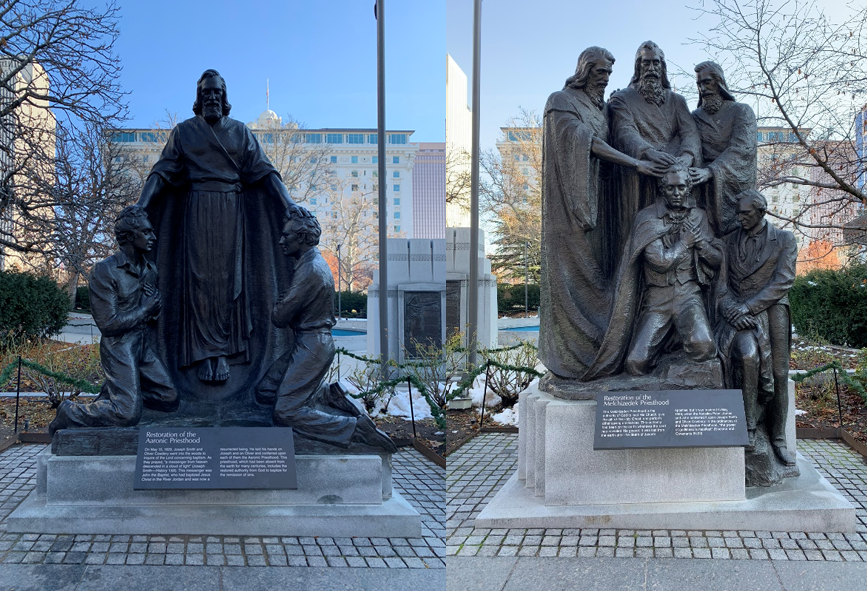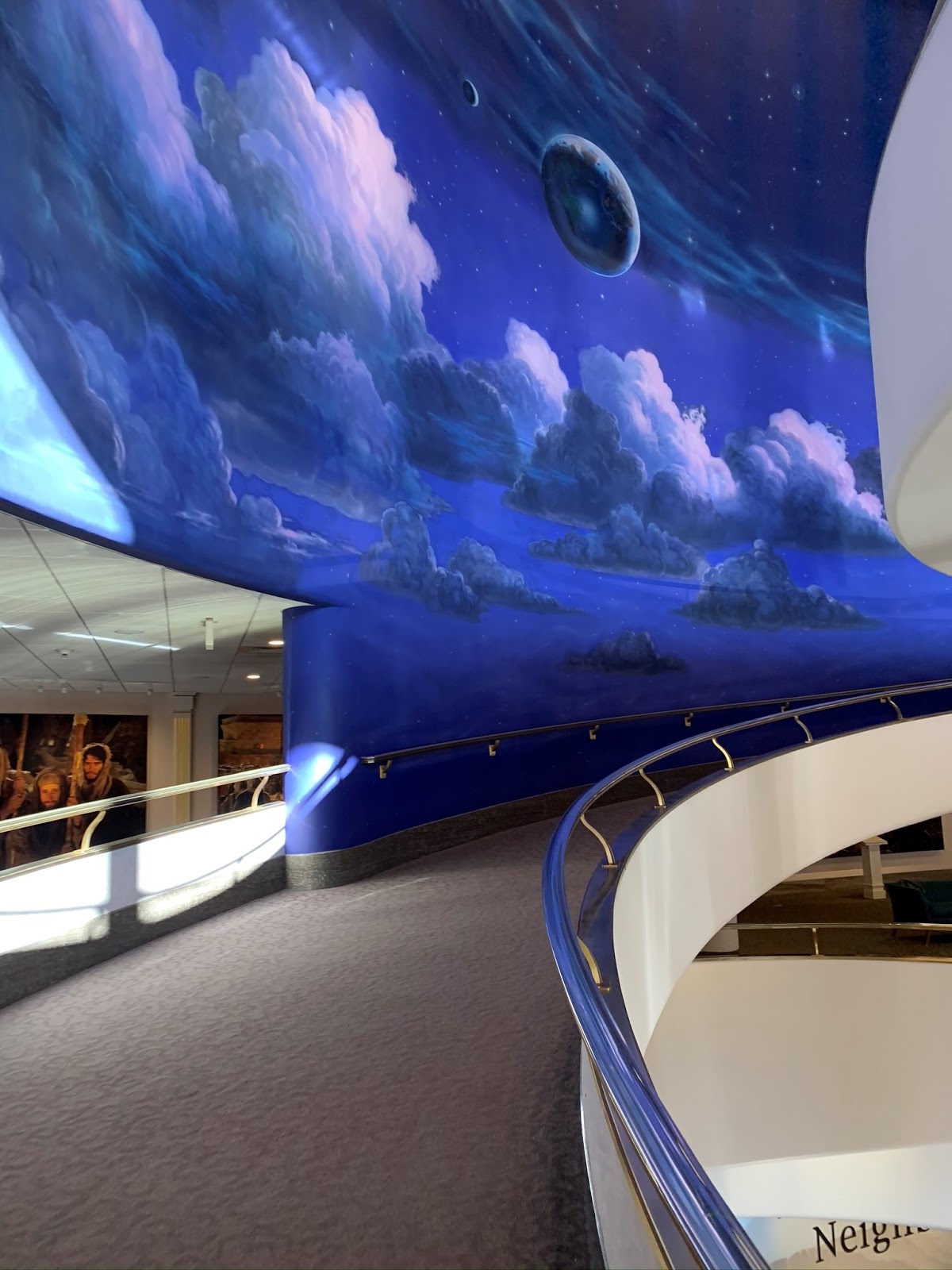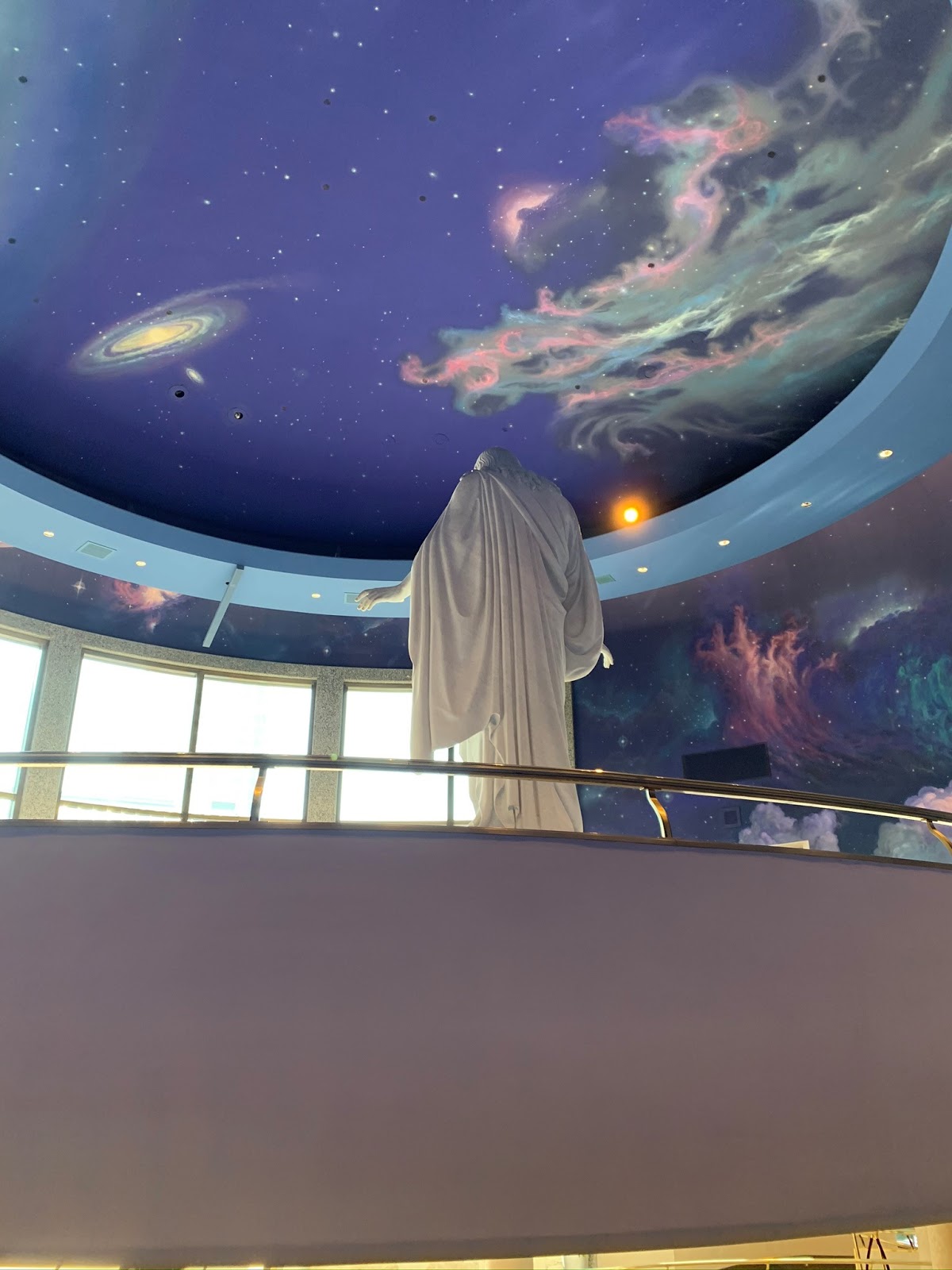There I stood; swayed, really. I was eight years old, in an ascending line curving up a long ramp into a domed rotunda. My parents insisted we stop by and say hello to the eleven-foot statue up top.
“We came all the way out here for the lights,” I remember my mother saying. “We might as well go inside.”
The line was long, fifteen people across, full of other Mormon families mecca-ing their way to kiss the ring at church headquarters. This was the North Visitor’s Center of Temple Square in December of 1992.
The Main Street Plaza was simply Main Street back then. The gorgeous City Creek Mall wasn’t even a twinkle in the Lord’s eye yet. Instead, and in its place, ZCMI and Crossroads Malls stood in mostly vacant shambles, unenthusiastically beckoning holiday visitors to cross the street and buy something at Hardee’s, by my memory, one of the last restaurants left in the largely unfurnished food court. Possibly thanks to an assist from Karl Malone who at the time could be seen in their commercials, Hardee’s was nearly alone in apparently weathering the city’s economic decline and progressing urban abandonment.
The Christmas lights and displays carefully erected by Temple Square seasonal employees months earlier were confined only to the one-square-block walled religious fortress, housing two plain visitor centers, the Assembly Hall, the domed Tabernacle with its brown rusted roof, and the crown jewel—Brigham Young’s temple.
Inside the North Visitor’s Center the crowd crept forward as an audience up top was dismissed at the conclusion of the audio presentation we had now heard twice just standing in line. As we rose up the ramp, the walls of painted clouds turned into murals depicting stars and planets and galaxies. The lights grew dimmer. We were entering an artist’s rendering of outer space.
Had I not known where we were, I might have thought we were visiting an astronomy museum.
But this was no visit to an astronomy museum. This was more like a religious pilgrimage in the headquarters of my carefully organized church. A pilgrimage my community had unanimously touted as important. Impactful. Inspirational. Iconic, even.
We were finally ushered into the room as children in galoshes and mittens stood from a handful of benches to be dragged out by parents to wander across the street and check out the line at Hardee’s. We took our seats on the now-vacant benches, directed by missionary volunteers to huddle in as close as possible to make room for the thronging crowds.
And then we looked up at him: a twentieth century marble replica of the Christus—a large statue of the resurrected Lord, bowing his head, his hands outstretched in omnipotent receipt and beckoning. The galactic mural surrounded him and us; a simple spotlight shined on him.

Suddenly the chatter of visitors died down and an echo of “shushes” filled the room as a billowing voice rained down from overhead speakers.
“I am Jesus Christ.”
*****
When my husband, Skylar, moved to Salt Lake City in 2016 he was suddenly faced with a religious culture so foreign to him he sometimes felt my family was bilingual.
Having never before been religious himself, he approached every new theological encounter with polite intrigue, even if also frequent bafflement.
“Can anyone go see the space Jesus or is that only for Mormons?” he asked me that December.
“Space Jesus?”
I wasn’t aware he had been exposed to photos of the North Visitor’s Center, and I’m still not sure how he came across them. His question was not unusual for him—at that time he was in the process of figuring out the distinction between the permitted entrance policies of the various church buildings.
“What if I borrowed someone’s recommend?” he had innocently asked me only a few weeks earlier. “Then could I go inside the temple and take a tour or something?”
I asked him why he wanted to go see “space Jesus.” He said it looked interesting and “strange.”
Growing up in Utah and in a Mormon family I had visited Temple Square hundreds of times by that point, and I guess I had become desensitized (if I was even “sensitized” in the first place) to what might seem odd to outside observers. It had never occurred to me that Temple Square was full of relics and displays that would baffle a person who didn’t grow up with pictures of God hanging in the bathrooms at home.
I don’t think, for example, I had ever even directly looked at the two side-by-side 12-foot statues just south of the temple depicting angels bestowing heavenly authority on 19th century church founders. But the same caught the puzzled attention of an out-of-town guest I had taken on a whirlwind tour of Temple Square in 2014.

“What is happening here?” she asked after stopping dead in her tracks, looking up, and then to me. “Can you explain this?”
“Probably,” I said in a voice I now realize was tired. “But then we might not have time for lemon drops in the Beehive House. No, not those kind.”
*****
The presentation continued as I sat huddled between my two parents. The Lord, with his strong Utah accent, skimmed through a divine autobiography, slipping in and out of scripture.
It probably only took five minutes, but I was eight, so it may as well have been an hour and a half. My mother’s hand squeezed my knee in an unspoken command to stop wildly swinging my legs that didn’t quite reach the floor. “I’m bored” I heard a little girl whine to her own parents on the row just behind me.
“Listen to Jesus” her father hissed back at her.
There was no way for me to know, or possibility to comprehend, that nearly thirty years later I would be pressured to revisit the same room with a new generation of eight-year-olds in galoshes and mittens. This time the pressure would come from a self-described agnostic I had only recently been legally allowed to marry.
“It’s really not as interesting as you think,” I tried to tell him. “Most kids have to get dragged there by their parents.”
Over the next couple of years we ended up at Temple Square dozens of times, usually giving a whirlwind tour of the Christmas displays to out-of-town guests and successfully side-stepping the goliath ordination statues.
“Eli could probably explain those to you,” Skylar will sometimes say, having now become an authority figure in his own right. “But then we might not have time for the pin-drop demonstration in the Tabernacle.”
“Can we finally go in?” Skylar has asked each time we’ve walked by the North Visitor’s Center, catching glimpses of the Christus through the large south-facing windows.
“That line.” I habitually say, probably not totally honest with myself about why I’m resisting. “Let’s come back during the non-Christmas season. Then we won’t have to wait in that line.”
I don’t know whether there really is a line when I say it. We never verify. My vague promise that I’ll take Skylar there on some undisclosed future date is usually enough to get him to drop it. He tends to tread lightly on the topic ever since a couple years ago I came across a box of objects in our basement that my formally-religious self once found sacred and it put me in a funk for a whole afternoon. That surprised him, and frankly it surprised me, too.
It’s possible he hasn’t been more pushy about the Christus because he hasn’t been able to gauge whether the topic is sensitive. I don’t know whether he’s actually thought that much about this. I’ve never asked him.
He’s been in Salt Lake City for over three years now, and it occurred to me yesterday that we still haven’t found a “non-Christmas season” time to stop by. I was thinking about this because I had just come across an article discussing the upcoming massive renovations to Temple Square. The South Visitor’s Center will be demolished. I don’t know what will ultimately happen to the North Visitor’s Center or the Christus or the space room. But change of some kind is possible. Maybe inevitable.
I was dragged in my galoshes and mittens in 1992 to that place, and then many more times thereafter, always under protest. I’ve avoided returning, despite the requests from a naïvely eager spouse. And yet, yesterday the article sort of felt like an announcement that my childhood was being deleted without my consent.
“Not the space Jesus,” I thought, as I pictured a wrecking ball gliding over the spot where the outer wall currently sits.
I work in an office building just across the street from Temple Square now. Every year I have a front-row seat to the assembly of the Christmas displays. The process is so meticulous, the lights so ubiquitous, that it takes several months on each end of the holiday to put them up and take them down.
I once heard the Golden Gate Bridge takes so long to paint that by the time they reach the end they have to go back to the beginning and start over—so they’re in perpetual paint mode. I think that’s just a myth, but the Temple Square Christmas lights feel like that to me, almost to the point that I wouldn’t be surprised to find out every strand has a person at each end undoing the action of the other. The place and areas around it are undergoing constant micro-changes in that way, so I suppose the occasional demolition and facelift shouldn’t really surprise me.
After reading the article I wondered how many more opportunities I would have to refuse to go see this thing in its perfectly-preserved 1992 state. Almost subconsciously I got up, walked out of my office, and took the elevator down to the lobby of my office building. I walked by the crowded and well-furnished food court at City Creek Mall. I crossed the street, weaving through the perfectly-manicured Main Street Plaza, into the Square’s gates, passed the temple and Tabernacle, and up to the North Visitor’s Center.
A mammoth-sized nativity scene sat on the lawn in front of the doors to the entrance—probably the same one from my childhood. The plastic faces on the Three Wise Men glistened in the winter sun, even under a thick patch of haze.
I wandered inside, passed two unassuming sister missionaries politely holding copies of The Book of Mormon, each with national flags poking out from under their name tags. One was the flag for South Korea; I didn’t recognize the other.
Having spent little time in Mormon church buildings in recent years, I was unexpectedly hit by the old familiar whiff of carpet cleaner and paper sacrament cups—a smell my childhood knew well.
There was no line on the winding ramp up to the domed rotunda because this was a weekday at 10:30 AM. So I proceeded, my hand lightly gliding across the rail attached to the curving wall. I stepped passed painted clouds and toward the stars and galaxies.

As I walked, I looked at the back of Jesus up above, his arms still outstretched, his head still bowed. He seemed bigger than I remembered, and that surprised me a little.

A moment later I arrived at the room where a young couple with a new baby and toddler sat on the same benches from 1992. The mom was breastfeeding and the dad was scrolling through something on his phone with the hand that wasn’t holding onto the shirt collar of the wiggling two-year-old. The couple was distracted, not really looking at the marbled deity before them.
And then a billowing voice rained down from overhead speakers.
Suddenly I was eight. My view of organized religion one-dimensional. No longer thinking about the heaviness I felt when I walked through the automatic sliding doors down by the sister missionaries from South Korea and not-South Korea. I had no worry about whether I was unequivocally welcome there—no internal battle to suppress an urge to be angry or sad.
Instead, my implicit and singular concern at the front of my mind as I stood near the breastfeeding mother and toddler-corralling father was how long I would be stuck there, like I was a child fully aware of the limitations of his attention span all over again.
I watched the toddler take a seat on the bench next to his dad, the boy’s legs swinging, mom now burping a fussy baby, as the Christus referred to itself as “the first and the last.”
There I stood; swayed, really, listening to Jesus, and trying to remember how long this presentation lasts, fully deceived by my childhood memory that suggested a run-time of an hour and a half. I watched the motionless centerpiece standing before me and amid the muraled universe as the Lord's voice quoted scripture.
"How long has this been going" a woman whispered to me, having just entered the room. "It just started," I told her in a voice I now realize was tired.
As the newcomer took a seat on the benches next to the parents who were quickly losing control of two impatient children, my phone vibrated in my pocket. It was an email, reminding me this was a work day.
Minutes later I wandered back to my office, passed the statues of pioneer brushes with the supernatural, and under a crane propping up a grounds employee who appeared to be rewrapping a tree branch with a strand of lights that was probably fine to begin with.
I crossed the street and got into the elevator in my office building lobby. A minute later I sat down in my chair and took a sip of my coffee that had cooled significantly during my short field trip that left me feeling nostalgically uneasy and honestly a little sad, even if I couldn’t quite explain why.
I started typing an email—something work related—something boring—something that couldn't seem to keep my attention.
Finally I gave up. I picked up my phone and searched Skylar’s name. A few seconds later he answered.
My voice cracked when I said it, and that surprised me a little.
“Hey Sky man. There’s actually not a line for the space Jesus if you go during the day.”
(Design: Josh Fowlke) (Editor: Rachel Swan)


